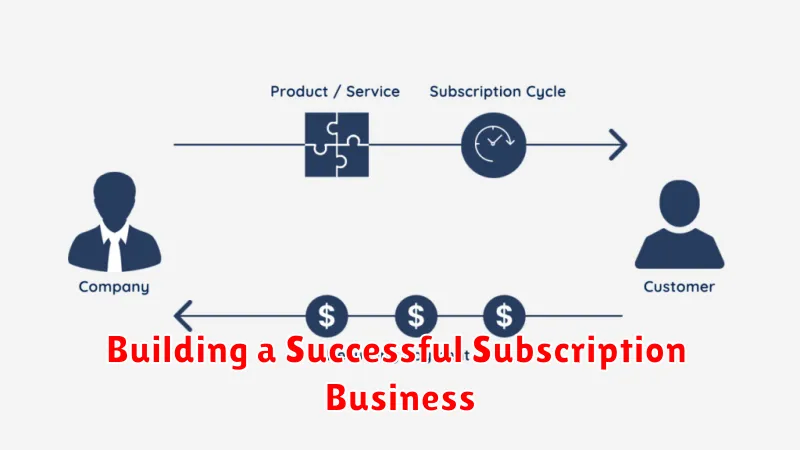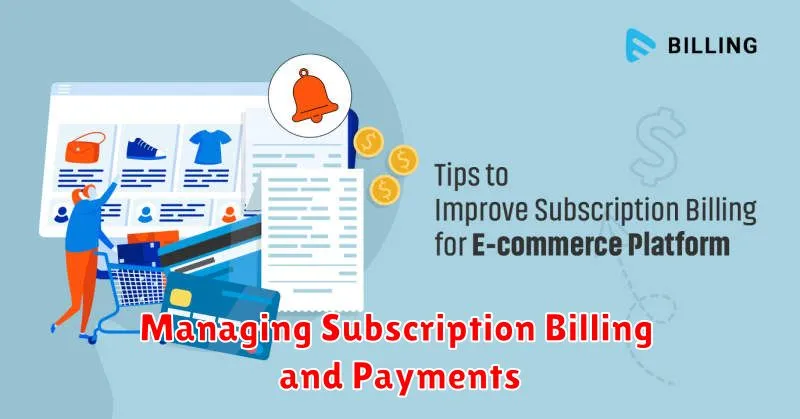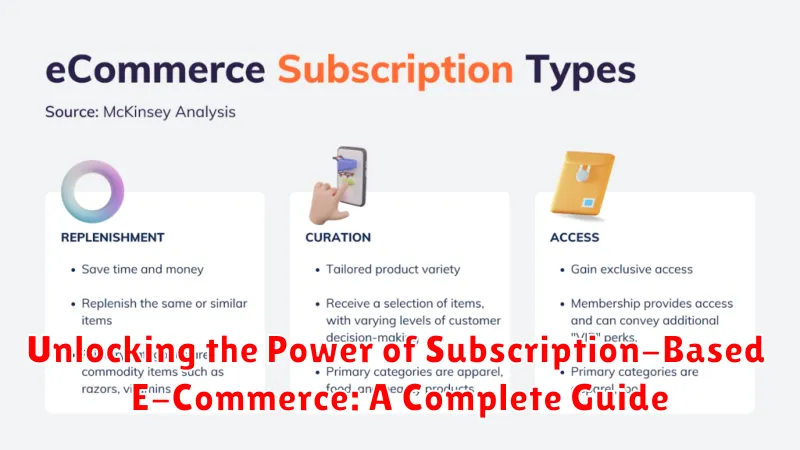In today’s dynamic digital marketplace, subscription-based e-commerce has emerged as a powerful business model, revolutionizing how consumers access products and services. This comprehensive guide delves into the intricacies of subscription e-commerce, offering valuable insights for businesses seeking to leverage its potential. We will explore the key benefits of adopting a subscription model, including predictable revenue streams, enhanced customer loyalty, and reduced customer acquisition costs. Understanding the nuances of subscription-based businesses is crucial for navigating this evolving landscape and achieving sustainable growth.
Whether you’re a seasoned entrepreneur or just starting out, this guide provides a roadmap to successfully implementing a subscription service. We will cover essential aspects, such as choosing the right subscription model, optimizing pricing strategies, building a compelling customer experience, and leveraging effective marketing techniques to attract and retain subscribers. Uncover the secrets to unlocking the power of subscription-based e-commerce and propel your business towards long-term success in the competitive online marketplace. From subscription box services to membership programs, this guide will equip you with the knowledge and tools needed to thrive.
What is Subscription-Based E-Commerce?
Subscription-based e-commerce, also known as subscription commerce or recurring billing, is a business model where customers pay a recurring fee at regular intervals (e.g., weekly, monthly, annually) to receive products or services. It’s a shift from one-time purchases to ongoing, predictable revenue streams.
Instead of purchasing a product outright, customers subscribe to receive it on a pre-defined schedule. This could range from physical goods like meal kits or beauty products to digital services like streaming platforms or software access. The core principle is the ongoing relationship between the business and the customer, fostered by continuous delivery and recurring payments.
This model provides customers with convenience and often cost savings, while businesses benefit from predictable revenue and increased customer lifetime value. Key elements include a clear subscription offering, a streamlined sign-up process, and ongoing customer management to ensure retention.
The Benefits of Subscription Models for Businesses
Subscription-based e-commerce offers numerous advantages for businesses. Predictable revenue is a key benefit, allowing for better financial forecasting and resource allocation. Recurring payments create a stable income stream, reducing reliance on one-time purchases.
Improved customer relationships are fostered through ongoing engagement and personalized service. Subscriptions encourage loyalty and create opportunities for upselling and cross-selling. This deeper understanding of customer preferences also enables businesses to tailor offerings and improve product development.
Reduced customer acquisition costs are another significant advantage. By focusing on retaining existing subscribers, businesses can decrease spending on acquiring new customers. The emphasis shifts from constant acquisition to nurturing long-term relationships, resulting in greater customer lifetime value.
Finally, subscription models offer inventory management efficiency. By accurately forecasting demand, businesses can optimize inventory levels and minimize waste. This predictable demand allows for streamlined production and logistics, contributing to overall cost savings.
Types of Subscription Services
Subscription services cater to a wide range of consumer needs and utilize various models. Understanding these distinctions is crucial for tailoring a successful subscription strategy.
Curation Subscription Boxes
These services focus on delivering a curated selection of products, often around a specific theme or niche. Examples include beauty products, pet supplies, or hobby-related items.
Replenishment Services
Replenishment subscriptions automate the purchase of essential, regularly consumed products. This model offers convenience for customers and predictable revenue for businesses. Common examples include household goods, personal care items, and pet food.
Access-Based Subscriptions
These subscriptions grant members exclusive access to content, software, or services. Examples range from streaming platforms and online learning programs to premium memberships for exclusive content or discounts.
Building a Successful Subscription Business

Building a thriving subscription business requires careful planning and execution. Product-market fit is paramount. Thoroughly research your target audience and ensure your subscription offering aligns with their needs and desires.
A seamless onboarding experience is crucial for converting trials into paying subscribers. Simplify the signup process and provide clear instructions on how to manage their subscription.
Pricing strategy plays a vital role in long-term success. Offer different tiers to cater to various customer segments and usage levels. Conduct thorough market research to determine optimal pricing.
Customer support is a cornerstone of retention. Provide prompt and helpful support across multiple channels to address subscriber inquiries and resolve issues effectively. Continuously gather customer feedback to refine your offerings and improve the overall subscriber experience.
Key Strategies for Customer Acquisition and Retention
Attracting and retaining subscribers requires a multi-faceted approach. Targeted advertising, focusing on the specific value proposition of your subscription service, is crucial. Clearly communicate the benefits, whether it’s convenience, exclusive access, or cost savings.
Content marketing plays a vital role in showcasing your expertise and building trust with potential subscribers. Creating valuable content relevant to your target audience establishes you as an authority and drives organic traffic.
Free trials and introductory offers can entice customers to experience your service firsthand, reducing the perceived risk associated with commitment. A seamless onboarding process is essential for converting trial users into paying subscribers.
Personalized communication throughout the customer lifecycle fosters loyalty. Regularly engage with subscribers through email newsletters, exclusive content, and personalized recommendations to reinforce the value of their subscription.
Finally, actively solicit feedback and adapt your offerings based on customer needs and preferences. This demonstrates a commitment to customer satisfaction and enhances long-term retention.
Choosing the Right Platform and Tools for Your Needs
Selecting the right platform and tools is crucial for the success of your subscription-based e-commerce business. Your chosen platform should seamlessly integrate with your business model and scale as you grow.
Consider factors like pricing, scalability, and integration capabilities when evaluating different platforms. Some platforms specialize in specific niches, such as digital content or physical goods, while others offer more generalized solutions. Choosing a platform that aligns with your specific needs will simplify operations and maximize efficiency.
Key tools to consider include subscription management software, payment gateways, and marketing automation platforms. These tools automate essential tasks like billing, customer communication, and marketing campaigns, freeing up your time to focus on other aspects of your business.
Thorough research and careful consideration of your specific requirements will ensure you choose the right platform and tools to support your subscription-based e-commerce venture.
Managing Subscription Billing and Payments

Effectively managing billing and payments is crucial for the success of any subscription-based e-commerce business. A seamless and reliable process ensures customer satisfaction and minimizes churn.
Choosing the right payment gateway is the first step. Consider factors like supported payment methods, transaction fees, and security features. Offering a variety of payment options, such as credit cards, debit cards, and digital wallets, caters to a wider customer base.
Automated billing systems are essential for managing recurring payments. These systems automate invoice generation, payment processing, and dunning management (the process of recovering failed payments). This automation reduces manual effort and improves efficiency.
Providing transparent billing information to customers is vital. Clearly communicate subscription terms, renewal dates, and payment amounts. Offer a user-friendly customer portal where subscribers can manage their subscriptions and payment details.
Best Practices for Customer Service and Communication
Exceptional customer service is crucial for subscription-based businesses. Proactive communication builds trust and reduces churn. Inform customers about upcoming renewals, payment processing, and any changes to their subscriptions.
Offer multiple communication channels. While email remains essential, consider live chat, social media, and in-app messaging for immediate support. Personalize interactions by using customer data to tailor messages and offers.
Efficiently manage customer inquiries. A robust help desk system with FAQs and readily available support agents can drastically improve customer satisfaction. Address issues promptly and follow up to ensure resolution. Regularly solicit feedback and actively use it to improve your service and offerings.
Scaling Your Subscription Business for Growth
Scaling a subscription business requires a strategic approach focused on sustainable growth. This involves optimizing various aspects of your operations, from marketing and customer acquisition to fulfillment and retention.
Customer Acquisition Cost (CAC) is a key metric to monitor. Analyze your marketing channels and identify the most cost-effective strategies for acquiring new subscribers. Experiment with different approaches, including targeted advertising, influencer marketing, and content marketing, to optimize your spending and maximize ROI.
Retention is crucial for long-term success. Focus on building strong customer relationships and providing exceptional value. Implement strategies to reduce churn, such as personalized communication, loyalty programs, and proactive customer support. Regularly analyze churn data to identify areas for improvement and implement targeted retention campaigns.
Automation can streamline various processes, freeing up resources for growth initiatives. Explore automation tools for tasks such as email marketing, billing, and customer support. This not only improves efficiency but also enhances the customer experience.
Finally, consider exploring new product offerings or service tiers to cater to a wider audience and increase average revenue per user (ARPU). Conduct market research to identify unmet needs and develop offerings that complement your existing subscription model.

